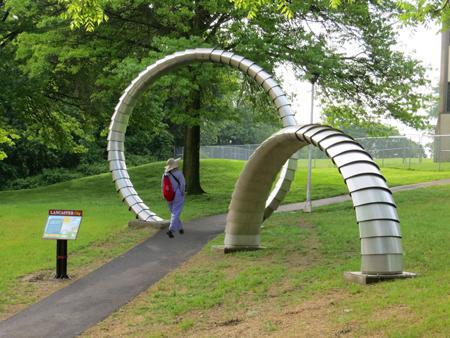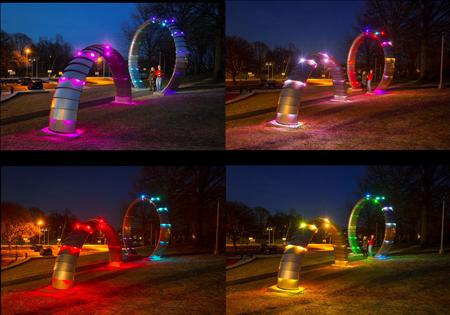- FMA
- The Fabricator
- FABTECH
- Canadian Metalworking
Categories
- Additive Manufacturing
- Aluminum Welding
- Arc Welding
- Assembly and Joining
- Automation and Robotics
- Bending and Forming
- Consumables
- Cutting and Weld Prep
- Electric Vehicles
- En Español
- Finishing
- Hydroforming
- Laser Cutting
- Laser Welding
- Machining
- Manufacturing Software
- Materials Handling
- Metals/Materials
- Oxyfuel Cutting
- Plasma Cutting
- Power Tools
- Punching and Other Holemaking
- Roll Forming
- Safety
- Sawing
- Shearing
- Shop Management
- Testing and Measuring
- Tube and Pipe Fabrication
- Tube and Pipe Production
- Waterjet Cutting
Industry Directory
Webcasts
Podcasts
FAB 40
Advertise
Subscribe
Account Login
Search
Attractive sculptures, day or night
Trio teams up to build interactive, illuminated sculptures
- By Eric Lundin
- October 7, 2013
- Article
- Arc Welding

Round objects abound outdoors: the sun, Frisbee® discs, and any game with a ball. This was the inspiration for “The Revolutions of Brandon Park,” a pair of sculptures that adorn a walking path in Brandon Park, Lancaster, Pa.
Although southern Arizona gets a fair amount of rain, about 12 in. annually, it’s known for the opposite weather condition—clear skies and lots of sunshine. Residents of Phoenix and Tucson and other area communities enjoy sunshine more than 350 days a year, and needless to say, solar power has an established and growing presence in this region.
While solar energy is used mainly for providing power for homes and businesses, it has other uses too. A team of three, Stephen Fairfield, Patrick Marcus, and Emily Taylor, use solar power to illuminate the sculptures they design. Their company, Solar Sculptures™, works with a variety of media that many other artists use, including metals, acrylic, plastic, resin, ceramic, wood, and cement. Also, like many artists, they incorporate features that capture, reflect, and scatter light, such as polycarbonate diffraction gratings and polished metal cylinders, planes, and spheres.
Where they differ from other artists is that they don’t merely use or play with light, their creations generate light. Solar panels harness the sun’s energy when the sun is up to power light-emitting diodes (LEDs) after the sun goes down, so the sculptures can be enjoyed at night.
Beyond Illumination
As anyone who has played with an electronics hobby kit knows, rigging up a solar panel or two to charge a battery, and connecting the battery to a light sensor to switch on some LEDs at dusk, is quite literally child’s play. Marcus’ contributions go much deeper.
“Our sculptures are interactive,” Marcus said. “We use passive infrared motion sensors that trigger subprograms in the software to make the LEDs change colors, patterns, and display frequency. People who are inquisitive by nature often notice that their presence has an impact on the sculpture, and before long they are playing with the sculpture, moving around in the sensors’ field of view, and using their movements to make continuous changes in the way the LEDs display.”
Marcus has the perfect background for this sort of work, a Bachelor of Science degree in electrical engineering and a doctoral degree in biomedical engineering with a minor in neuroscience. His postgraduate work provides keen insight in understanding how visual stimuli are interpreted by the brain, while his undergraduate degree enables him to create circuits and systems that generate stunning visual stimuli and, at the same time, use little power.
“A display that uses 100 high-power LEDs often uses as little as 35 watts,” Marcus said. “That’s half as much as a common household desk lamp. This allows us to use solar power in nearly all of our creations, even if the installation location isn’t as sunny as southern Arizona.”
Working in Harmony
Although the use of solar power is the group’s signature element, this isn’t the only way in which their creations work in harmony with the environment. Taylor specializes in planning public spaces and works with Fairfield at the design stage, shaping the concept so that it fits into the local surroundings, reflects the local culture, and will have the widespread appeal that public art should have.
Much more than an esoteric role, Taylor helps with sketches, then works up detailed daytime and nighttime 3-D renderings and incorporates site imagery so that the team can get a comprehensive understanding of the final product as it will appear by day and at night. She also has a primary role in fundraising, using the renderings to promote the projects, and she works as a liaison to the fabricators that do the actual fabrication and assembly.

“The Revolutions of Brandon Park” becomes interactive when the sun goes down. The display is in a low-activity mode until a passerby triggers one of the motion sensors. The software then switches the program to a dynamic mode, and the program feeds off the pedestrian’s motions, changing the colors and patterns displayed by the LEDs. See it in action at http://bit.ly/19h4s4I.
Fairfield is quick to point out that Solar Sculptures owes a debt of gratitude to the fabricators they work with, who also make suggestions to ensure the projects are fabricated in ways that make sense, conserve resources, and often prevent unnecessary costs.
“We often work in a big scale,” Fairfield said. “‘Spirit of Southern Arizona’ at the Tucson International Airport is 19 ft. tall, and ‘Revolutions of Brandon Park’ in Lancaster, Pa., is a two-element installation, the larger of which is a 16-ft.-dia. circle. The fabricators we work with often make practical suggestions in material, design, and fabrication, and their suggestions often make a big difference.
“Ken Mellinger, the owner of Mellinger Manufacturing Co., suggested a design change that made hauling and installing the larger ‘Revolution’ more practical and significantly more cost-effective,” Fairfield said. “Because of his suggestion, we didn’t need to get a permit from the Dept. of Transportation, move any power lines, or make any special arrangements for the installation.”
About the Author

Eric Lundin
2135 Point Blvd
Elgin, IL 60123
815-227-8262
Eric Lundin worked on The Tube & Pipe Journal from 2000 to 2022.
subscribe now

The Fabricator is North America's leading magazine for the metal forming and fabricating industry. The magazine delivers the news, technical articles, and case histories that enable fabricators to do their jobs more efficiently. The Fabricator has served the industry since 1970.
start your free subscription- Stay connected from anywhere

Easily access valuable industry resources now with full access to the digital edition of The Fabricator.

Easily access valuable industry resources now with full access to the digital edition of The Welder.

Easily access valuable industry resources now with full access to the digital edition of The Tube and Pipe Journal.
- Podcasting
- Podcast:
- The Fabricator Podcast
- Published:
- 04/16/2024
- Running Time:
- 63:29
In this episode of The Fabricator Podcast, Caleb Chamberlain, co-founder and CEO of OSH Cut, discusses his company’s...
- Trending Articles
Capturing, recording equipment inspection data for FMEA

Tips for creating sheet metal tubes with perforations

Are two heads better than one in fiber laser cutting?

Supporting the metal fabricating industry through FMA

Hypertherm Associates implements Rapyuta Robotics AMRs in warehouse

- Industry Events
16th Annual Safety Conference
- April 30 - May 1, 2024
- Elgin,
Pipe and Tube Conference
- May 21 - 22, 2024
- Omaha, NE
World-Class Roll Forming Workshop
- June 5 - 6, 2024
- Louisville, KY
Advanced Laser Application Workshop
- June 25 - 27, 2024
- Novi, MI


























